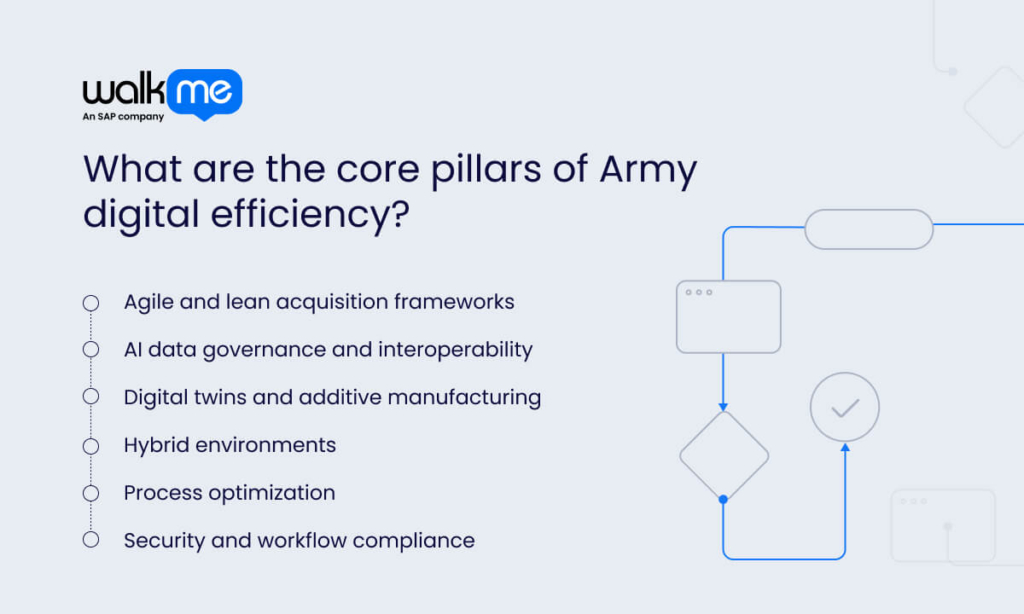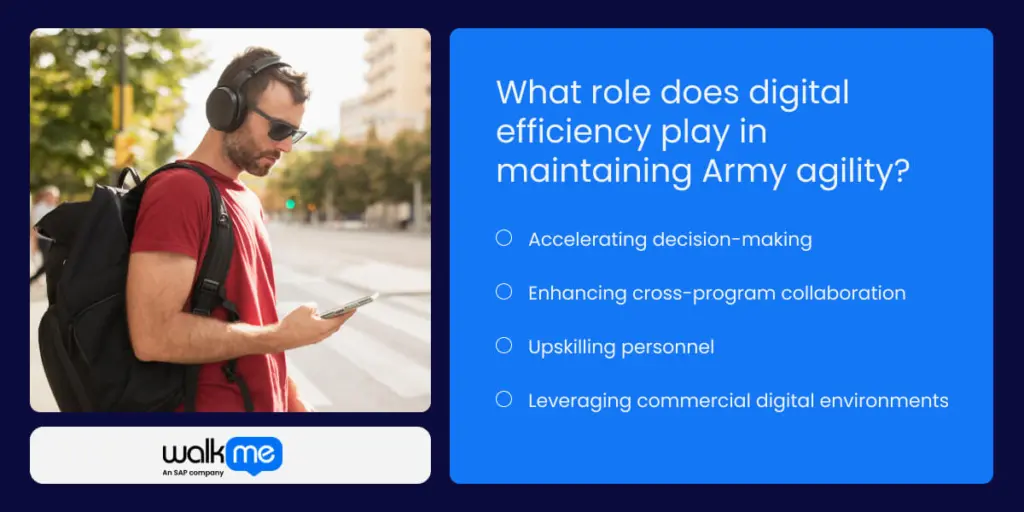The United States Army is among the largest in the world, with over 2.8 million employees worldwide.
Digital efficiency used to be a support function that helped the Army utilize its numerous logistical systems. Today, it’s crucial for everything from battlefield communications to real-time decision-making across global operations.
Take the Digital Engineering Directive from the DoD, for example, a mandate that digs deeper and directly reshapes how the Army designs, tests, and fields new systems. It replaces static documentation with dynamic, data-driven models that constantly evolve.
It cannot be overstated how important digital efficiency will be for the U.S. Army moving into the next decade. Widespread integration of digital tools, process automation, and AI-assisted planning will determine how quickly and precisely the Army can respond, adapt, and execute across every level of command.
This article examines digital efficiency in the U.S. Army, highlighting real-world initiatives, core principles, and future strategies that drive faster development, better decision-making, and stronger mission outcomes.
What is digital efficiency in the Army?
Digital efficiency in the U.S. Army means using technology to sharpen every mission phase from planning to execution.
It streamlines complex systems like supply chain management and battlefield communications, reducing delays and errors.
For example, Project Convergence is a real-world event that connects soldiers, drones, and command centers through the use of AI and big data analytics. This project wants to “ensure future war-fighting readiness,” and includes participation from countries such as France, Japan, U.K., U.S.
In this regard, digital efficiency transforms cumbersome processes into innovative and globally collaborative solutions. For the Army, it’s a shift in strategy that reduces friction, strengthens adaptability, and ensures forces remain ahead in fast-moving conflicts.
Why is digital efficiency in the US Army important?
Digital efficiency is significant today because the U.S. Army operates in fast, unpredictable environments where every second counts. It means using technology to get the right information to the right people quickly.
For example, the Army’s use of automated supply chains enables the real-time tracking of equipment and supplies. This reduces delays and prevents shortages in critical moments.
When the Army operates with digital efficiency in mind, it can adapt to changing threats and save more lives.
Without digital efficiency procedures, IT operations would be slower and more complex, putting soldiers at risk and weakening the chances of mission success.
What is the Army’s digital engineering directive?
The U.S. Army’s digital engineering directive marks a major shift in how the military builds and manages its technology.
Instead of relying on traditional paper documents and fixed designs, the directive pushes for digital models that are updated continually.
This means engineers and soldiers can work with real-time data, making changes faster and more accurately. The end goal is to speed up how quickly new equipment is designed, tested, and sent to the field.
Using digital tools, the Army can identify problems early and address them before they become costly mistakes. This approach also makes it easier to share information across different teams and departments. It also helps breaks down data silos that slowed development in the past.
The directive supports modern technology like simulations, AI, and advanced analytics to improve decision-making. As a result, the Army can better adapt to new threats and maintain the reliability of its various systems.
What are the core pillars of Army digital efficiency?

Having an understanding of basic digital efficiency in the U.S. Army will be beneficial in this section. You already know it depends on speeding up information flow, automating tasks, and connecting people and systems.
These efforts aren’t isolated and work together to support larger goals across missions, logistics, and planning. The core pillars of Army digital efficiency provide the foundation for transforming how operations are carried out.
Let’s take a closer look:
Agile and lean acquisition frameworks
The Army utilizes agile change management to develop new technology more quickly and efficiently. Instead of slow, rigid steps, teams work in short cycles to test and improve designs. This helps deliver new tools and weapons to soldiers, keeping them prepared for fast-changing battlefield challenges.
AI data governance and interoperability
AI data governance means setting clear directions to handle and protect information. Interoperability allows different Army systems to connect and share data. Together, they make sure information flows quickly and safely across various units. This means leaders obtain accurate, up-to-date details when they need them most, improving decisions in critical moments.
Digital twins and additive manufacturing
Digital twin technology is a virtual copy of equipment that shows how machines are working in real-time. Using 3D printing, the Army can quickly make or replace parts when needed. This approach cuts downtime and preserves equipment, making repairs faster and saving valuable resources during missions.
Hybrid environments
The Army must decide whether to rent digital tools from cloud providers or build its own systems. Renting is faster and more flexible, but it offers less control. Building takes more time but creates tailored solutions. Combining both options helps balance speed, cost, and security to meet the Army’s distinctive needs.
Process optimization
The Army enhances its operations by collecting ongoing feedback and addressing issues promptly. Standardized processes mean everyone follows the same clear steps. Together, these methods make operations easier to train, helping soldiers and leaders achieve better results on the job.
Security and workflow compliance
Security is built into every step of the Army’s digital workflows from the start. Strict rules protect sensitive data from hacking and human errors. Security issues and AI regulatory compliance are addressed early, ensuring the Army maintains information security. This also enables swift, confident decisions in high-pressure situations and complex missions.
What role does digital efficiency play in maintaining Army agility?

Now that you have an understanding of the core pillars of digital efficiency, it’s time to take a look at its role in maintaining Army agility.
This might seem like a broad concept, but in practice, digital efficiency is what allows the Army to adapt quickly. It’s how the Army is able to shift direction, scale operations, and respond to new threats without hesitation.
Let’s take a closer look at the role of digital efficiency in maintaining agility in the U.S. Army:
Accelerating decision-making
The Army’s Tactical Intelligence Targeting Access Node (TITAN) demonstrates how effective data governance accelerates decision-making. TITAN brings together sensor data from satellites, drones, and ground units into one shared system.
Rules on how data is organized, shared, and verified help remove clutter and prevent delays. Instead of digging through multiple systems, commanders get accurate, real-time intelligence they can act on. This makes decision-making quicker, more confident, and mission-ready.
Enhancing cross-program collaboration
Work on the Common Hypersonic Glide Body (CHGB) highlights the importance of standard contracts. Multiple Army teams, from research to testing, had to coordinate fast. Instead of creating separate agreements, they used shared templates and processes across the board.
That kept timelines aligned and reduced back-and-forth. Everyone operated from the same playbook. This resulted in faster collaboration, less confusion, and smoother progress from development to delivery across all connected programs.
Upskilling personnel
At the Army’s DEVCOM centers, engineers are learning with the same digital tools used in the private sector. Training programs focus on platforms such as Siemens NX and MATLAB, which are used to model next-generation systems, including future Army helicopters.
Soldiers and civilians acquire practical skills that they can apply immediately, enabling the Army to build advanced systems faster and with fewer errors.
Leveraging commercial digital environments
The Army’s cloud environment offers a smarter way to build and test digital tools. Instead of waiting for custom infrastructure, teams use secure, commercial platforms like AWS and Azure, which are managed by the Army’s Enterprise Cloud Management Agency.
For example, logistics teams can use cArmy to prototype a supply tracking app in just a few weeks. It’s faster, cheaper, and more adaptable, giving squads room to innovate with commercial resources.
What’s next for Army digital efficiency?
Digital efficiency in the U.S. Army is crucial as we move into the next decade.
Technology is advancing at an unprecedented rate, and the Army must keep pace with this advancement and continue to innovate.
A key aspect of digital efficiency is that it’s an ongoing process. As new technologies emerge, efficiency mandates must follow. Viewing digital efficiency this way and aligning new developments with a clear strategy is essential.
When systems work well, those successes need to be captured as data and scaled across the department. The days of fractured, data-siloed, or segmented systems are behind us.
Wide-scale digital efficiency in the Army marks the start of a new, unified digital era.
FAQs
The Army uses strong cybersecurity tools like encryption, access controls, and secure cloud networks to protect digital engineering data. All systems must follow strict DoD security standards. Regular audits and real-time monitoring help catch threats early. This ensures sensitive data stays safe across different programs and teams.
The Army tracks return on investment (ROI) by measuring time saved, cost reductions, and performance improvements. For example, faster system development or fewer errors during testing show strong results. Data is collected across programs to compare outcomes and determine what’s working and where changes are needed.
Legacy Army systems weren’t built for today’s digital tools, which makes upgrades difficult. Some lack the compatibility or data formats needed to connect. Training teams to use new tools also adds to the complexity of the process. The Army works to bridge these gaps while maintaining security and ensuring mission readiness during any transition.

